
Ernest Augustus, Crown Prince of Hanover, 3rd Duke of Cumberland and Teviotdale, was the eldest child and only son of George V of Hanover and his wife, Marie of Saxe-Altenburg. Ernest Augustus was deprived of the throne of Hanover upon its annexation by Prussia in 1866 and later the Duchy of Brunswick in 1884. Ernest Augustus was deprived of his British peerages and honours for having sided with Germany in World War I.

Albrecht, Duke and Crown Prince of Württemberg was the last heir presumptive to the Kingdom of Württemberg, a German military commander of World War I, and the head of the House of Württemberg from 1921 to his death.
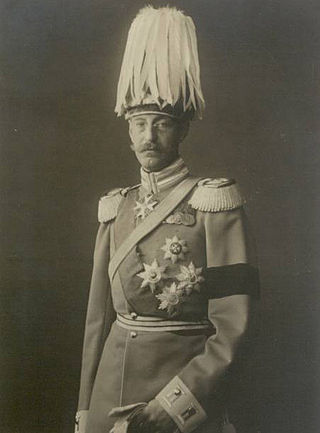
Prince Wilhelm of Urach, Count of Württemberg, 2nd Duke of Urach, was a German prince who was elected in June 1918 as King of Lithuania, with the regnal name of Mindaugas II. He never assumed the crown, however, as German authorities declared the election invalid; the invitation was withdrawn in November 1918. From 17 July 1869 until his death, he was the head of the morganatic Urach branch of the House of Württemberg.
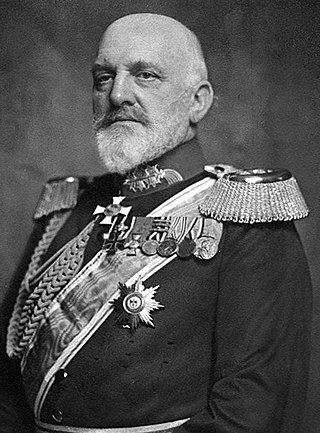
Josias von Heeringen was a German general of the imperial era who served as Prussian Minister of War and saw service in the First World War.

The Order of Civil and Military Merit of Adolph of Nassau is an order of merit of the Grand Duchy of Luxembourg for meritorious service to the Grand Duke, the Grand-Ducal House and Luxembourg. It was founded in 1858 as a chivalric order of the Duchy of Nassau by Adolphe of Nassau in honor of his namesake and ancestor, Adolf, Count of Nassau, the only member of the House of Nassau to have been Roman King of Germany. After the Duchy of Nassau was annexed by Prussia in 1866 and Adolphe became Grand Duke of Luxembourg in 1890, he revived the order as an order of merit.

Frederick II was the last sovereign Grand Duke of Baden, reigning from 1907 until the abolition of the German monarchies in 1918. The Weimar-era state of Baden originated from the area of the Grand Duchy of Baden.
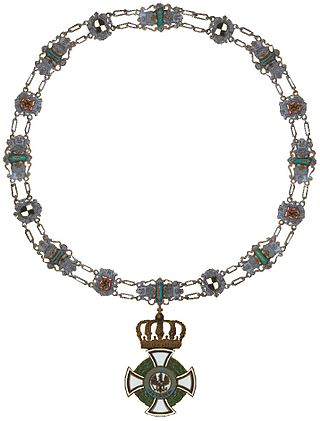
The House Order of Hohenzollern was a dynastic order of knighthood of the House of Hohenzollern awarded to military commissioned officers and civilians of comparable status. Associated with the various versions of the order were crosses and medals which could be awarded to lower-ranking soldiers and civilians.

Philipp Albrecht, Duke of Württemberg was the son of Albrecht, Duke of Württemberg, and Archduchess Margarete Sophie of Austria. He was born in Stuttgart, and became head of the formerly reigning royal House of Württemberg on the death of his father on 29 October 1939. He died in Ravensburg, aged 81.
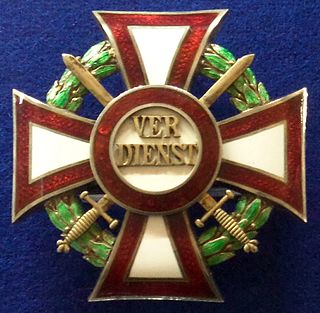
The Military Merit Cross was a decoration of the Empire of Austria and, after the establishment of the Dual Monarchy in 1867, the Empire of Austria-Hungary. It was first established on October 22, 1849 and underwent several revisions to its design and award criteria over the years of its existence. It became obsolete in 1918 with the dissolution of the Austro-Hungarian Empire.

The Military Merit Cross (Militärverdienstkreuz) was established by Friedrich Franz II, Grand Duke of Mecklenburg-Schwerin on August 5, 1848. Mecklenburg-Schwerin, a grand duchy located in northern Germany, was a member of the German Confederation and later the German Empire.

The House and Merit Order of Duke Peter Frederick Louis or proper German Oldenburg House and Merit Order of Duke Peter Frederick Louis was a civil and military order of the Grand Duchy of Oldenburg, a member state of the German Empire. The order was founded by Grand Duke Augustus of Oldenburg on 27 November 1838, to honor his father, Peter Frederick Louis of Oldenburg. It became obsolete in 1918 after the abdication of the last grand duke.
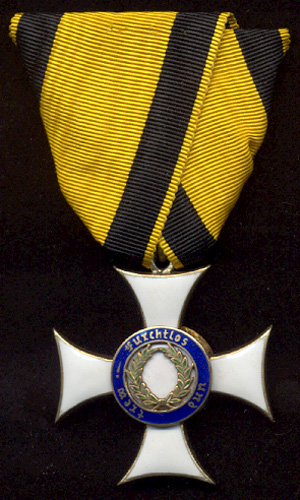
The Military Merit Order (Militärverdienstorden) was a military order of the Kingdom of Württemberg, which joined the German Empire in 1871. The order was one of the older military orders of the states of the German Empire. It was founded on 11 February 1759 by Karl Eugen, Duke of Württemberg as the Militär-Carls-Orden, and was renamed the Militärverdienstorden on 11 November 1806 by King Friedrich I. The order underwent several more revisions over the course of the 19th and early 20th centuries. It became obsolete with the fall of the Württemberg monarchy in the wake of Germany's defeat in World War I.

Prince Franz of Bavaria was a member of the Bavarian Royal House of Wittelsbach and a Major General in the Bavarian Army.

Duke Robert Maria Klemens Philipp Joseph of Württemberg was a member of the House of Württemberg and a Duke of Württemberg.
The Brunswick War Merit Cross also known as the Ernst-Augustkreuz, was a military decoration of the Duchy of Brunswick. The Cross was established 23 October 1914 by Ernest Augustus, Duke of Brunswick. The cross was awarded to all ranks for distinction in war. On 20 March 1918, a first class of the Cross was created in pinback form, with the existing Cross becoming the second class. This brought the Cross in line with awards of other German States like Prussia with the Iron Cross. The cross was awarded on a blue ribbon with yellow stripes for combatants and on a yellow ribbon with blue stripes for non-combatants.
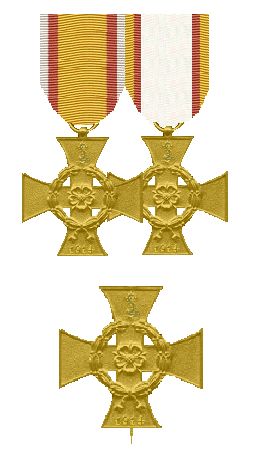
The War Merit Cross was a military decoration of the Principality of Lippe. Established on 8 December 1914, by Leopold IV, Prince of Lippe, it could be awarded to combatants and to non-combatants for significant contributions to the war effort. The cross was awarded approximately 18,000 times to combatants and 1,100 times to non-combatants.

The War Merit Cross was a military decoration of the Kingdom of Saxony. Established 30 October 1915 by King Frederick Augustus III of Saxony, it was awarded for humanitarian and patriotic work towards the war effort.
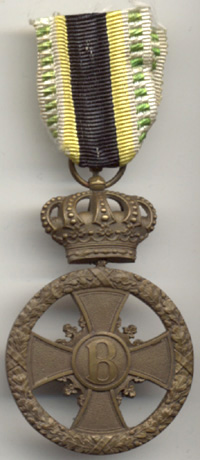
The Cross for Merit in War was a military decoration of the Duchy of Saxe-Meiningen established by Bernhard III, Duke of Saxe-Meiningen on 7 March 1915.

The Military Karl-Friedrich Merit Order was a military order of merit of the Grand Duchy of Baden. Established 5 October 1805 by Charles Frederick, Elector and later Grand Duke of Baden, the order recognized outstanding military merit amongst military officers. In 1807, medals associated with the order were added as the highest awards for bravery for non-commissioned and enlisted soldiers.

The House Order of Henry the Lion In German: Hausorden Heinrichs des Löwen, was the House Order of the Duchy of Brunswick. It was instituted by William VIII, Duke of Brunswick on 25 April 1834. The ribbon of the Order was red with yellow edges. It had five grades: Grand Cross, Grand Commander with Sash, Commander, Knight 1st Class, Knight 2nd Class, plus Medal of Merit for Science and Arts, the Cross of Merit and the Medal of Honour. The Order was named in honour of Henry the Lion, who remains a popular figure to this day.



















